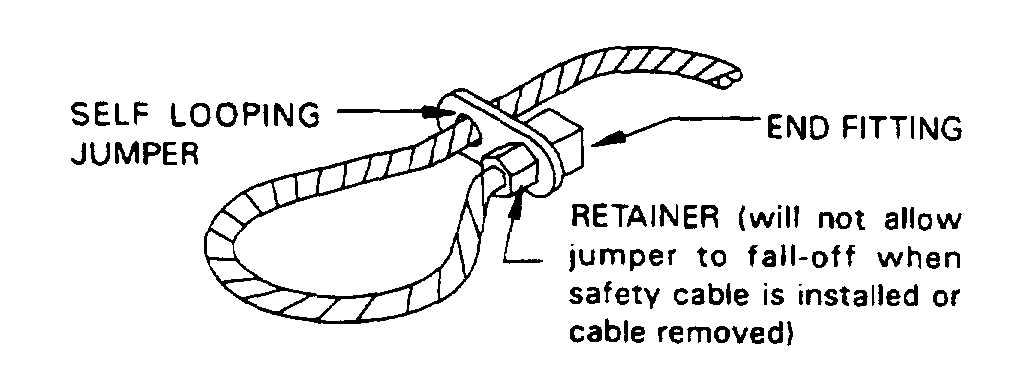TM 1-1500-204-23-6
c.
Safety Cable Installation. Safety cable may
be used as a substitute for lockwire to prevent loosening
during service. Threaded parts, such as drilled-head
bolts, fillister head screws, turnbuckles, thumbscrews,
hose fittings and electrical connectors, plugs, caps, and
similar items are within the scope of the safety cable
application. The following rules shall apply when using
safety cable.
NOTE
Routing of safety cable may vary from
that of lockwire in order to achieve a
proper installation.
(1)
When safety cable is being substituted
for lockwire in an existing installation (maintenance,
rework, etc.), equivalent diameter safety cable to that of
the lockwire shall be selected for use, providing that
selection criteria for safety cable as defined in the (1)
General Instructions are met.
(2)
Adjacent Units. Safety cable shall be
installed in such a manner that any tendency for a
fastener to loosen will be counteracted by an additional
tension on the cable. Safety cable shall be threaded
through the fasteners in such a way as to produce
installed safety cable with either positive or neutral pull.
(3)
Maximum Span. The maximum span
of safety cable between two termination points shall be
6 inch (152.4 mm) unless otherwise specified.
CAUTION
Installing Defects: Any cable defect
(nick,
fray,
kink,
or
any
other
mutilation of the safety cable) found
prior to, during, or subsequent to
installation, is not acceptable.
Figure 2-84. Self Looping Safety Cable TM 1-1500-
204-23-6
NOTE
Avoid kinks or sharp bends while
handling and threading safety cable.
(4)
Installing Holes. Safety cable must be
installed through the holes intended for this purpose in
the part being secured, or through the holes provided in
a self looping device secured to the safety cable by the
safety cable manufacturer (figure 2-84). In applications
where holes are not provided for safety cable in the
component to which it is attached the self looping safety
cable may be used in a manner like, or similar to figure
2-85.
Figure 2-85. Self Looping Safety Cable Anchored to
a Pin Assembly
(5)
Safety Cable/Ferrule Reuse. Safety
cable and ferrule shall be new upon each application.
Reuse is not allowed.
(6)
Installation. Various examples of
safety cable installation are shown in this section. All
possible combinations and applications are not shown.
Unless
otherwise
specified
in
the
application
engineering drawing, safety cable shall be installed in
two or three bolt patterns with two bolt patterns being the
preferred method where an even number of fasteners
are to be secured. The installer must adhere to the
basic rules outlined in this manual.
(7)
Hose Fittings and Electrical Connector
Requirements. Hose fittings and electrical coupling nuts
shall have safety cable installed in the same manner as
tube coupling nuts.
(8)
Excess Cable. After Installing safety
cable, excess cable from the crimped ferrule shall be
cut by the installation tool. The maximum allowable
length of cable extending beyond the ferrule shall be
0.031 inch (0.79 mm).
(9)
Crimping Requirements (Pull-Off Load,
Reference Table 2-19). Safety cable shall be installed
with the safety cable manufacturers recommended tool,
which has been tested and calibrated in accordance with
procedures specified in this manual.
Change 2 2-85



